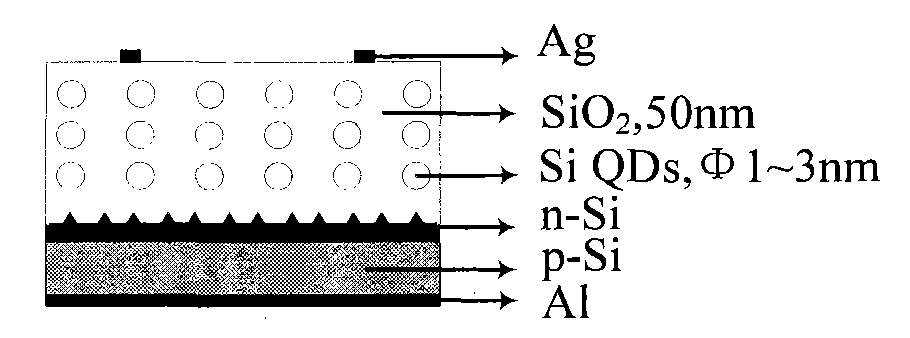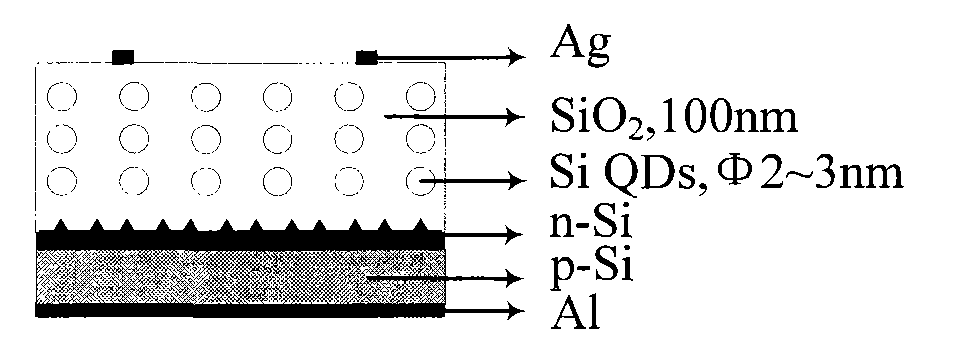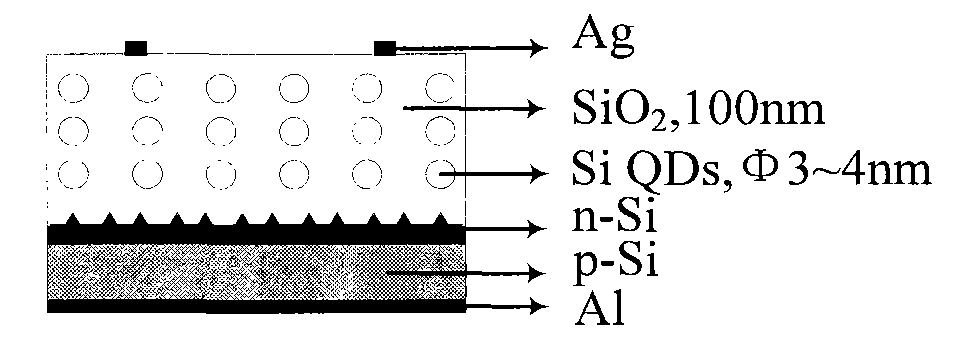Silicon quantum dot solar cell and preparation method thereof
A technology of solar cells and silicon quantum dots, applied in circuits, electrical components, photovoltaic power generation, etc., can solve the problems of high cost, many materials, light-induced attenuation effect, etc. simple effect
- Summary
- Abstract
- Description
- Claims
- Application Information
AI Technical Summary
Problems solved by technology
Method used
Image
Examples
Embodiment 1
[0051] Prepare p-type (100) crystalline silicon with a thickness of 200um, and its boron doping concentration is 10 15 cm -3 , with a resistivity of 5 ohm cm, used as a substrate after cleaning with a standard semiconductor process;
[0052] On the p-type crystalline silicon substrate, sodium silicate Na with a mass fraction of 1.6% 2 SiO 3 , Sodium hydroxide NaOH with a mass fraction of 2.0% and isopropanol IPA solution with a volume fraction of 6% for texturing, that is, a water bath at 78°C to 83°C for 25 minutes to form a surface pyramid structure with a height of 6um to 8um to reduce the solar cell Surface reflectivity, increase the absorption coefficient of sunlight;
[0053] Diffusion of phosphorus oxychloride on the p-type crystalline silicon substrate to form a phosphorus concentration of 10 15 cm -3 The n-type layer;
[0054] Using PVD, that is, magnetron sputtering, a silicon monoxide film with a thickness of 50nm is prepared on the substrate with a silicon mo...
Embodiment 2
[0060] Prepare p-type (100) crystalline silicon with a thickness of 200um, and its boron doping concentration is 10 15 cm -3 , with a resistivity of 5 ohm cm, used as a substrate after cleaning with a standard semiconductor process;
[0061] On the p-type crystalline silicon substrate, sodium silicate Na with a mass fraction of 1.6% 2 SiO 3 , Sodium hydroxide NaOH with a mass fraction of 2.0% and isopropanol IPA solution with a volume fraction of 6% for texturing, that is, a water bath at 78°C to 83°C for 25 minutes to form a surface pyramid structure with a height of 6um to 8um to reduce the solar cell Surface reflectivity, increase the absorption coefficient of sunlight;
[0062] Diffusion of phosphorus oxychloride on the p-type crystalline silicon substrate to form a phosphorus concentration of 10 15 cm -3 The n-type layer;
[0063] Using PVD, that is, magnetron sputtering, a silicon monoxide film with a thickness of 100nm is prepared on the substrate with a silicon m...
Embodiment 3
[0069] Prepare p-type (100) crystalline silicon with a thickness of 200um, and its boron doping concentration is 10 15 cm -3 , with a resistivity of 5 ohm cm, used as a substrate after cleaning with a standard semiconductor process;
[0070] On the p-type crystalline silicon substrate, sodium silicate Na with a mass fraction of 1.6% 2 SiO 3 , Sodium hydroxide NaOH with a mass fraction of 2.0% and isopropanol IPA solution with a volume fraction of 6% for texturing, that is, a water bath at 78°C to 83°C for 25 minutes to form a surface pyramid structure with a height of 6um to 8um to reduce the solar cell Surface reflectivity, increase the absorption coefficient of sunlight;
[0071] Diffusion of phosphorus oxychloride on the p-type crystalline silicon substrate to form a phosphorus concentration of 10 15 cm -3 The n-type layer;
[0072] Using PVD, that is, the method of magnetron sputtering, a silicon monoxide film with a thickness of 100nm is prepared on the substrate wi...
PUM
| Property | Measurement | Unit |
|---|---|---|
| Average height | aaaaa | aaaaa |
| Thickness | aaaaa | aaaaa |
| Thickness | aaaaa | aaaaa |
Abstract
Description
Claims
Application Information
 Login to View More
Login to View More - R&D
- Intellectual Property
- Life Sciences
- Materials
- Tech Scout
- Unparalleled Data Quality
- Higher Quality Content
- 60% Fewer Hallucinations
Browse by: Latest US Patents, China's latest patents, Technical Efficacy Thesaurus, Application Domain, Technology Topic, Popular Technical Reports.
© 2025 PatSnap. All rights reserved.Legal|Privacy policy|Modern Slavery Act Transparency Statement|Sitemap|About US| Contact US: help@patsnap.com



